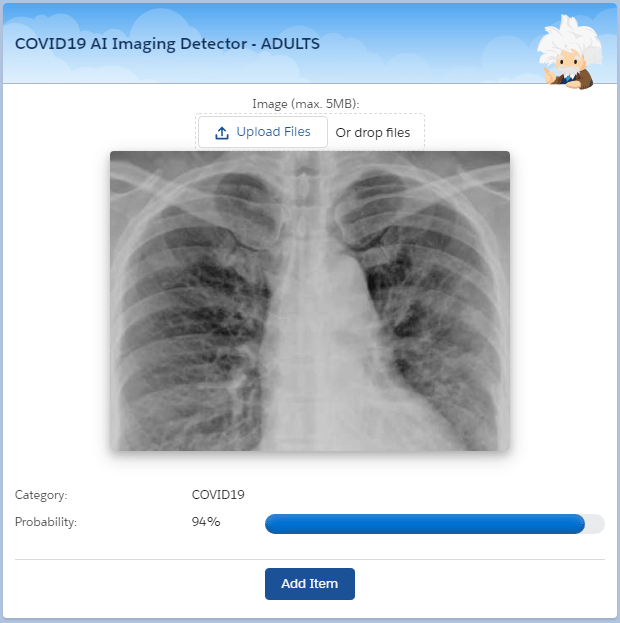
Detect COVID-19 on X-ray images using Einstein Vision
The health care system in many parts of the world had been hit hard by the current COVID 19 pandemic rendering its resources vulnerable and inadequate. This created major struggles across the globe, including, but not limited to:
• Scarcity of manpower with unmatched influx of patients.
• Lack of appropriate expertise at the frontline due to relocation of physicians from different specialties.
• High acuity of cases that needs prompt identification and intervention.
Artificial Intelligence; with its vast potentials and versatile applications is capable to help in the fight against COVID 19 in numerous ways particularly in the field of imaging diagnostics. AI in imaging diagnostics during the COVID 19 pandemic is of particular need especially that many physicians at the front line are not experienced to accurately interpret imaging modalities nor do hospitals have enough radiologists to provide timely reports.
The App
At Avity, we always strive to develop solutions to arising issues; we worked on developing a prototype for an AI-powered app that is capable of instantly identifying COVID-19 changes on chest x-rays. This was made possible using our favorite platform Salesforce and its Einstein’s deep learning APIs. We believe this app could assist medical staffs with limited knowledge in radiology to identify likely COVID 19 cases, also it could help radiologists to classify hundreds of chest x-ray images in few minutes; prioritizing highly suspicious cases and thereby saving time and resources.
In the following demo, we will provide the gender, age group and the x-ray view type for four different patients. After uploading each chest x-ray, Einstein Vision will display the results instantly. Currently the model is capable to classify images as NORMAL, COVID19, and OTHER PNEUMONIA. While chest CT scans have shown to be more sensitive in detecting changes related to COVID 19, the high radiation exposure and the lack of availability of this resource in many facilities make the use of chest x-rays more accessible. Therefore, we trained our model on x-ray images.
Take a look at this quick demo:
The app on Salesforce Mobile

Performance and Results
We have used around 500 images to train the model; while, ideally at least 1000 images for each label are required, but the scarcity of chest x-rays images for COVID19 patients was the limitation. Hopefully, we can have access to more data when more is unraveled about this novel virus globally.
Currently the model’s prediction accuracy for each of COVID19, NORMAL and OTHER PNEUMONIA is 80%, 95% and 60% respectively. The reason why the latter have lower accuracy is because COVID 19 can causes changes similar to that in pneumonia. Perhaps CT scans will be a better choice to improve this prediction.
DISCLAIMER
This article and the prototype app are not meant to be a reliable, highly accurate COVID-19 diagnostic system, nor has it been professionally or academically vetted. The methods and techniques used in this article are meant for educational purposes only. This is not a scientifically rigorous study. The app is still in the prototype phase and NOT FOR MEDICAL USE.

